Double-action revolvers are not easy to shoot fast and accurately. The double-action trigger stroke is hard to master, compared to a semi-automatic, plus magnum revolvers transfer all of the recoil into the shooter’s hand. A semi-auto absorbs some recoil as the mechanism cycles. What good revolver shooting comes down to is grip, trigger control, and sight picture. And, obviously, a revolver set up to do your bidding.
We wanted to take a look at full-size revolvers with 4-inch barrels and adjustable sights. What makes these models suitable for target work are adjustable sights and larger grips. Revolvers like these should be able to pull both target duty and defense duty as needed. Three such revolvers are the new Colt King Cobra Target and the new Kimber K6s Target, as well as a more affordable choice, a used but like-new Ruger Security-Six. This trio of stainless wheelguns with 4-inch pipes and larger grips are just the thing for when you want more accuracy and velocity out of the 357 Magnum. They are also pussycats when you fire 38 Special loads.
All three of these wheelguns have matte stainless-steel finishes, adjustable rear sights, ramp front sights, and wood grips. These also have exposed hammers so the user can fire them in double-action mode or single-action mode. We tested in both modes and found we had a preference for the Kimber in double-action mode over the other guns.
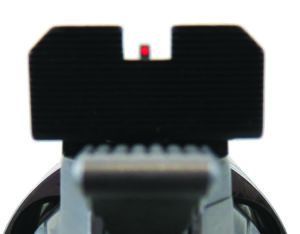
The first technique in fast shooting revolver is grip. Your grip should be firm and high on the backstrap while still allowing you to stroke the trigger in double-action mode and ensure the hammer spur does not pinch the web of your shooting hand. Now you know why Jerry Miculek removes the hammer spurs on his revolvers. In fast double-action speed shooting, there is no need for a hammer spur. A high grip allows for better recoil control. Because revolvers have a lot of distance from grip to the center axis of the bore, there is more pronounced muzzle flip. A high grip closer to the bore axis helps reduce this flip. We found we could get a high grip on all of the revolvers, some better than others. With the Kimber, the high grip was the most comfortable. With a high grip on the Ruger and Colt, the recoil from 357 Magnum ammo made shooting uncomfortable, but tolerable. With 38 Special ammo, there is less recoil, and we were able to comfortably hot rod all three revolvers with a high grip. The second factor in going fast is trigger control, which means using the distal or first joint of your trigger finger. This gives you more leverage to stroke the long, heavy double-action trigger. We dry-fired these revolvers in double-action trigger mode to acclimate ourselves to the trigger pulls. The Kimber and Colt by far had the lighter and smoother double-action trigger pulls. The Ruger was a bit harder to stroke smoothly. The double-action trigger pull weight on the Colt and Kimber was 8.5 and 9.9 pounds, respectively. The Ruger had a 10.3-pound double-action pull weight.
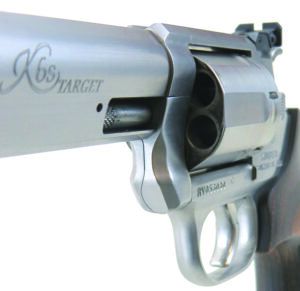
The third thing to consider is sight picture. Keep your eye on the front sight; the target should be a bit fuzzy in the background. While you recover from recoil, start your double-action trigger pull. With better revolvers, you will know the stroke length required to fire the revolver. As you are pulling back the trigger, recovering from recoil and controlling the front on target, complete the trigger stroke to fire the gun.
Our pre-range check on revolvers — new or used — is to examine cylinder-to-frame gap with a feeler gauge and use our range rod match kit ($130; Brownells.com) to check barrel and chamber alignment. All three guns were in spec. The space from the forcing cone to the front of the cylinder should be from 0.004 to 0.010 inches. The Colt had the tightest at 0.004 inches, and the Ruger and Kimber both measured 0.005 inches. This is tight, and indicated there would be little splash.
For accuracy testing, we fired in single-action mode with targets set at 15 yards. We used both 38 Special and 357 Magnum ammo. Ammo brands were Armscor 38 Special loaded with 158-grain full-metal-jacket bullets, SIG V-Crown 357 Magnum loaded with 125-grain jacketed hollow points, and Federal Hydra-Shok Low Recoil 357 Magnums, loaded with 130-grain JHPs. While the Federal was marked low recoil, we did not notice a substantial difference in felt recoil. We also noticed the casings for this round stuck in the chambers, requiring use of the ejector to shuck the empty cases. With the Armscor and SIG ammos, empties fell free from the chambers.
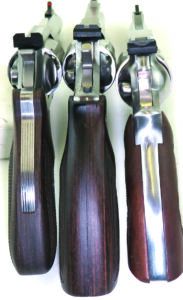
For speed shooting, we moved the targets to 10 yards and used Thompson Target B27Q-RED Silhouette Qualification targets ($15; ThompsonTarget.com). These targets are full-torso life-size Police B27 and FBI Q center mass human silhouette designs. We started with guns at low ready and fired six rounds as fast as we could while keeping them in the center-of-mass zone. The weight of these revolvers helped to mitigate recoil. The Ruger was the hefty gun in the bunch, weighing 36.1 ounces unloaded. The Colt weighed 32.4 ounces, and the Kimber was the lightest at 31.8 ounces. The Ruger held its weight in its heavy frame and cylinder. You can feel the weight of Ruger just above the tip of your trigger finger. The Kimber had a similar balance point, just above the tip of the trigger finger, and it sports a full-lug barrel. The weight of the Colt was farther back in the grip of the hand.
In our opinion, all of these 357s would be good for self defense. The Kimber or Colt would be our choice for a competition revolver. The Ruger is built like a tank and offers good accuracy. The Colt has better sights and makes a good option for defense and target work — it was the most accurate revolver of the group — but it still has that retro revolver feel to it. The Kimber is a newer design that does a good job of evolving the revolver category. In more detail, here’s our spin on what these wheelguns bring to the table for the discriminating shooter:
Gun Tests Grade: B+
$1012
The DASA 4-inch Target shares the same frame as the snubnose iterations of K6s and the same traits: slab-side cylinder, flat-bottom trigger guard, and high grip. With all the K6s revolvers we’ve tested, we’ve found you can get a high, comfortable grip and still easily operate the trigger at warp speed. The Target variant is equipped with a 4-inch tube with a full lug. On the barrel is dovetailed an adjustable rear sight that can be swapped out for the fixed Kimber combat sight. Finally, the Target model has larger wood grips that are thin, yet they fill an average-size hand better.
| Action Type | Revolver, double action |
| Overall Length | 8.6 in. |
| Barrel Length | 4.0 in. |
| Barrel Twist Rate | 1:18.75 in. |
| Sight Radius | 6.1 in. |
| Overall Height | 5.0 in. |
| Maximum Width | 1.3 in. |
| Weight Unloaded | 29 oz. |
| Weight Loaded | 31.8 oz. |
| Cylinder Gap | 0.005 in. |
| Capacity | 6 |
| Frame Material | Matte stainless steel |
| Barrel/Cylinder Material | Matte stainless steel |
| Frame Front Strap Height | 2.3 in. |
| Frame Back Strap Height | 3.5 in. |
| Grip | Checkered walnut |
| Grip Thickness (max) | 1.0 in. |
| Grip Circumference (max) | 4.5 in. |
| Front Sight | Red fiber optic, removable |
| Rear Sight | Adjustable notch |
| Trigger Pull Weight (DA) | 9.9 lbs. |
| Trigger Pull Weight (SA) | 3.4 lbs. |
| Trigger Span (DA) | 2.9 in. |
| Trigger Span (SA) | 2.5 in. |
| Safety | Internal hammer block |
| Warranty | 1-year limited |
| Telephone | (888) 243-4522 |
| Website | KimberAmerica.com |
| Made In | USA |
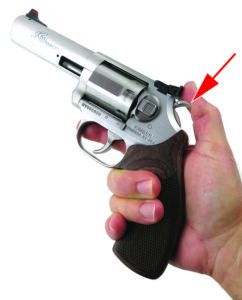
Let’s start with what we don’t like about the K6s. First is the price. We understand why the revolver is so expensive because it is well made. It has a nice matte-stainless-steel finish and well-fitted stocks that take time and cost money. The second thing we don’t like is the close distance between the hammer spur and the rear sight. Every time we thumbed back the hammer, our thumb pad scraped down the rear sight. It looks like Kimber uses the same hammer in all the K6 models. Due to the sights being deeper, the hammer needs to recontoured. The third thing is the short ejector rod. Some cases stuck, and we would have liked more leverage to evict empty cases from the chambers.
So what did we like? The accuracy was excellent when we did our part. The best five-shot group with Armscor 38 Special was 1.97 inches, and with Federal 357 Magnums, it was 1.43 inches. The high grip is another plus for the K6s. It is high yet still allows the user to stroke the trigger with not a lot of effort. The double-action trigger-pull weight was 9.9 pounds, but it felt like less. We could also stage the trigger, meaning squeeze back and hold the trigger just before its breaking point until we got back on target. We also found it easy to just pull through the trigger stroke. We also liked how the stocks filled the gap behind the trigger guard. They were also thin at the top, then slightly swelled in the palm. The wood grip is rounded at the butt and had a checkered texture. Finally the sights worked well on the K6s. The front sight is an orange fiber-optic pipe built into the squared-off ramp front sight. The rear sight was a squared-off notch with a serrated face, so the square ramp front sight was easy to align in the notch. The rear sight resisted glare better than the rear sights on the Ruger and Colt. The front sight is pinned in place, and as we mentioned the rear is dovetailed, so swapping out sights is easily accomplished.
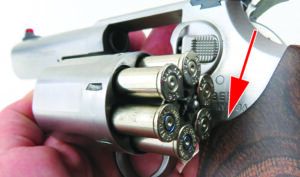
The K6s Target displays craftsmanship in terms of looks and mechanics. There was a very slight wiggle in the cylinder. The barrel was blended nicely into the frame. In fact, the exterior of the K6s was quite smooth, except for the edges of the target sights. The cylinder chambers are recessed, and the recoil shield allow the user to see which chambers are loaded or hold a case. The cylinder also lacks flutes and instead has flat, slab sides on the outside. This make the K6s only 1.3 inches wide.
To open the cylinder, there is a finely checkered button that the user presses in to push out the cylinder from the frame, similar to a Ruger DA/SA revolver. We found it easy to operate. The end of the ejector rod locks up with a pin in the ejector rod housing. The frame uses a side plate on the right side of the frame, similar to Smith & Wesson DA/SA revolvers.
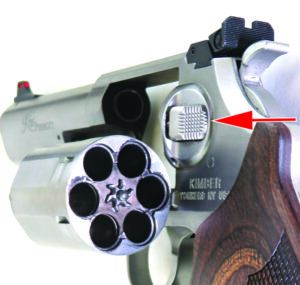
The trigger had a medium width and was smooth. The hammer spur was checkered and offered plenty of real estate to cock the hammer but, as mentioned, was too close to the rear sight.
The accuracy was darn good. On average, across all calibers and ammo brands, groups measured 2.3 inches. Some of those tight groups were accomplished due the light 3.4-pound single-action trigger pull. That trigger helps to make the K6s surgical. Dropping the hammer for speed, we found it easy to control the K6s with 357 Magnum and 38 Special loads. We could run this gun fast and accurate, which we attribute to the trigger and sights. Recoil was manageable, though we thought the exposed steel backstrap would slap us silly with magnum loads. We were wrong; recoil was very tolerable. Looking at the data, however, we saw the K6s had less muzzle velocity than the Colt or Ruger, about 50 fps less.
Our Team Said: The K6s Target has good sights, a smooth trigger pull, and ergonomic grip. While it was the lightest in the test, it handled well with magnum loads. We dinged it a half grade due to the hammer spur being too close to the rear sight.
38 Special/357 Magnum Range Data
To collect accuracy data, we fired five-shot groups from a bench using a rest. Distance: 15 yards, open sights. We recorded ve-locities using a ProChrono DLX digital chronograph set 10 feet from the muzzle.| 38 Special Armscor 158-grain FMJ | Colt King Cobra Target | Ruger Security-Six | Kimber K6 Target |
| Average Velocity | 873 fps | 872 fps | 827 fps |
| Muzzle Energy | 267 ft.-lbs. | 267 ft.-lbs. | 240 ft.-lbs. |
| Smallest Group | 1.77 in. | 2.58 in. | 1.97 in. |
| Average Group | 1.85 in. | 2.63 in. | 2.13 in. |
| 357 Magnum SIG V-Crown 125-grain JHP | Colt King Cobra Target | Ruger Security-Six | Kimber K6 Target |
| Average Velocity | 1404 fps | 1410 fps | 1353 fps |
| Muzzle Energy | 547 ft.-lbs. | 552 ft.-lbs. | 516 ft.-lbs. |
| Smallest Group | 2.48 in. | 2.39 in. | 3.21 in. |
| Average Group | 2.68 in. | 3.06 in. | 3.35 in. |
| 357 Magnum Federal Hydra-Shok Low Recoil 130-grain JHP | Colt King Cobra Target | Ruger Security-Six | Kimber K6 Target |
| Average Velocity | 1363 fps | 1412 fps | 1284 fps |
| Muzzle Energy | 536 ft.-lbs. | 576 ft.-lbs. | 476 ft.-lbs. |
| Smallest Group | 1.81 in. | 2.15 in. | 1.43 in. |
| Average Group | 2.01 in. | 2.25 in. | 1.45 in. |
Value Guide: 38 Special/357 Magnum Revolver Rankings
| Gun Name | Issue | Grade | Comments |
|---|---|---|---|
| Ruger GP100 1707 357 Magnum, $613 | Jun. 2022 | A | Best Buy. Reliable, accurate, and smooth handling. The grips were a bit angular, but that’s a matter of taste. |
| Colt Python PYTHON-SP6WTS 357 Magnum, $1498 | Jun. 2022 | A | Our Pick. Reliable, accurate, very smooth, exceptionally well finished. Is it worth the money? We think so. |
| Colt MK V Peacekeeper 357 Magnum, $1000 | Jun. 2022 | A | Reliability was faultless and accuracy good, but not the top of the test. Buy a modern revolver instead. |
| Smith & Wesson Pro 686 Plus 178038 357 Magnum, $1037 | Jun. 2022 | D | Nagging misfires were deal breakers. We liked the smoothness of the revolver. The grips were ideal. |
| Taurus Tracker 692 38 Sp./357 Mag./9mm Luger, $487 | Oct. 2021 | A | Our Pick. Excellent versatility. Other revolvers do not have this versatility or offer seven shots. |
| Taurus Defender 856 2-85639NS 38 Sp. +P, $306 | Oct. 2021 | A- | Best Buy. Offers six-shot capacity, a 3-inch heavy barrel, and a tritium-insert front-sight. |
| EAA Weihrauch Windicator 741566103612 357 Mag., $394 | Oct. 2021 | A | Need a house gun or truck gun to be fired occasionally, but which must always come up shooting? This is it. |
| Rock Island Armory M206 51283 38 Sp., $240 | Oct. 2021 | B | We disliked the too-long hammer spur, and the wooden concealment grips are not well designed. |
| Taurus 856 Defender Ultra-Lite 2-85639ULNS 38 Sp. +P, $405 | Aug. 2021 | A | Offered good accuracy and is ultra-lightweight. The DA trigger pull was smooth but heavy, with a bit of stacking. |
| Taurus Tracker 692 2-692039 9mm/38 Sp./357 Mag., $705 | Mar. 2021 | A- | Offers a lot of versatility with the extra cylinder assembly. The price is reasonable. |
| Colt Python (2020) PYTHON-SP4WTS 357 Magnum, $1300 | Jan. 2021 | A | Pricey, but the new Python is a winner, even if it isn’t an exact clone of the original Python. |
| Colt Python (2020) PYTHON-SP6WTS 357 Magnum, $1800 | Jan. 2021 | A | We really liked the trigger and found the revolver to be quite accurate. |
| Colt Python (1980) 357 Magnum, ~$2500 | Jan. 2021 | A | The trigger is superb and the royal blue finish is brilliant. The aftermarket Hogue grip helps reduce felt recoil. |
| Colt Python (1964) 357 Magnum, $1800 | Jan. 2021 | A- | It provided good performance and accuracy. This is a shooter and perhaps is a candidate for restoration. |
| Colt King Cobra KCOBRA-SB3BB 357 Magnum, $838 | May. 2020 | A | The revolver offers good performance with the 3-inch barrel and is well made. Carrying it takes a bit of effort. |
| Rock Island Armory AL3.0 357 Magnum, $504 | May. 2020 | A- | There was a lot to like, price, accuracy, shooting comfort. Not a beautiful revolver for sure. |
| Rossi Model 971 VRC 357 Magnum, $295 | May. 2020 | B | A great trigger, and the porting helped keep us on target. But the accuracy was less than stellar. |
| Taurus Model 66 2-660041 357 Magnum, $371 | Oct. 2019 | A | Well suited to personal defense and home defense. Good field gun for protection against animals. |
| Taurus 608 Matte Stainless 2-608049 357 Magnum, $548 | Oct. 2019 | A- | It is a big gun. Just the same, the size and eight-shot capacity made it ideal for home defense. |
| Smith & Wesson M27 Classic 150339 357 Magnum, $909 | Oct. 2019 | B- | The grips are not the best design for handling magnum loads. Trigger action was the big problem, very heavy. |
| Ruger GP100 KGP-141 357 Magnum, $500 | Sep. 2018 | A | The stainless-steel GP100 performs in all categories: accuracy, smoothness, control, and velocity. |

























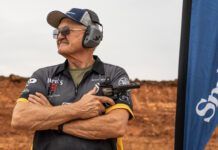
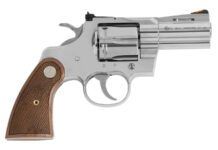


Do you happen to know the exact barrel lengths of the king cobra and Ruger you compared to? I know my Kimber K6S target measures 3 15/16”. This seems to be the case for all Kimber revolvers in that they are little shorter than advertised. Just wondering if this is what might be the cause of the lower fps.